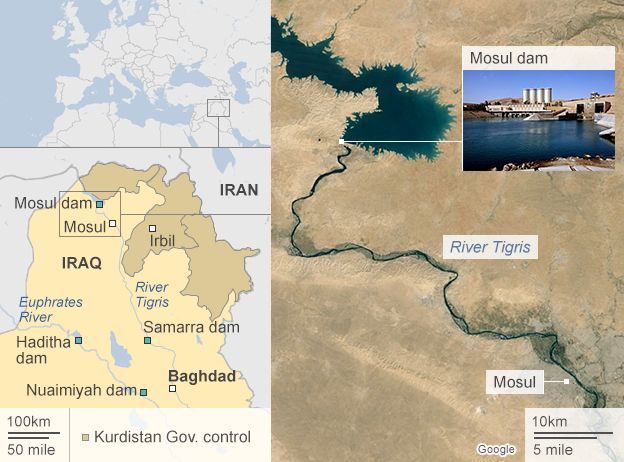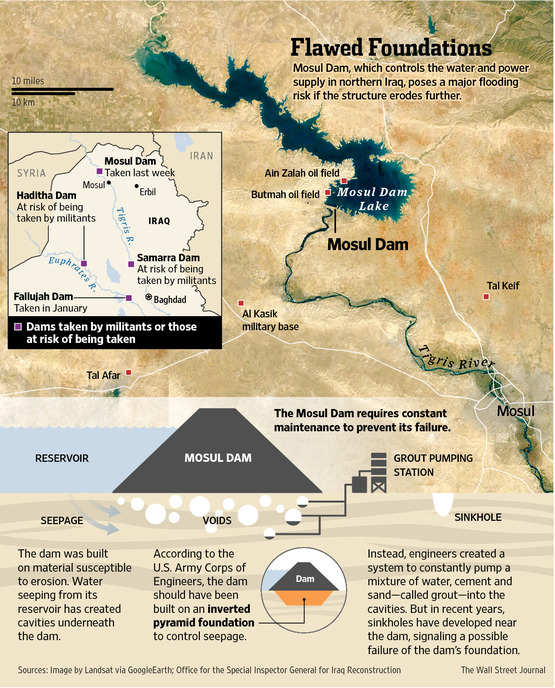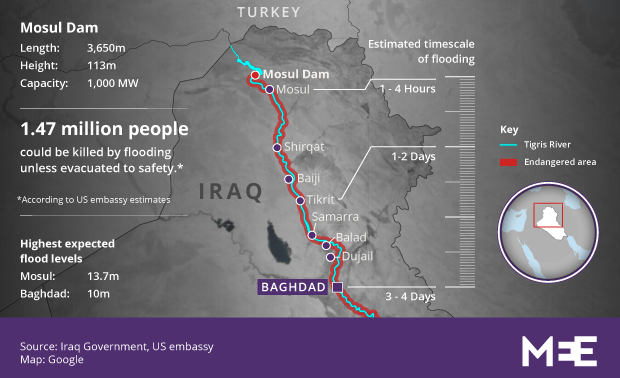It’s hard for most people to imagine the force of floodwaters from a dam. In the picture above, that huge piece of the damn was carried more than a quarter of a mile downstream. Here’s a more human scale to the size of the blocks:
Now imagine a dam that impounds almost 30 times as much water as did the St. Francis dam. Imagine that it’s built on rock that dissolves constantly requiring millions of pounds of cement and grout to be pumped into it continuously over 30 years. Can’t happen in the modern world, you say? Let me introduce you to the Mosul Dam sitting a few miles to the north of Mosul, Iraq:
This dam tops the world in anyone’s list of unsafe dams. To say that its collapse would be catastrophic is an understatement.
For some reason, this story hasn’t gotten much media attention. I first read about it in Dexter Filkins’ piece in the January 2, 2017 edition of The New Yorker about the dam in Mosul, Iraq. (Other publications and news-gathering organizations, such as the BBC and the Wall Street Journal, have reported on this story as well, but it hasn’t made its way into much of the national media). I warn you up front: you won’t like what you read.
The Mosul Dam was constructed in 1984. Iraq had periodically suffered flooding along the Tigris River, and the Syrians and Turks were busy damming the Tigris and Euphrates Rivers in their countries, resulting in a serious loss of water to Iraq farmers. Although the Iraqis were at war in 1984 with the Islamic Republic of Iran, there was enough surplus from the 1970’s oil boom left over to build the dam.
The location itself was good for a dam. It was fairly flat, near mountains, and the topography was such that a huge lake could be supported by the dam. The problem is that the ground around where the dam was built and the reservoir it would generate was made up largely of carbonates, gypsum, limestone, and marl (a cabonate-rich mud), all of which dissolve easily in water and form karsts (when you hear “karst,” think Florida or the Yucatan and their sinkholes):
Bad as this is in urban or suburban areas, it’s catastrophic around a dam. If the water gets far enough down, it can start “piping” under the dam, and the dam will eventually be undermined and will collapse.
All this was known to the Iraqis, but in a government of one-man rule, whatever the ruler wants, he gets, and so Saddam Hussein got his dam (which was named after him at the time). Built into the construction was the requirement that the karsts appearing be filled with cement. That has continued nonstop for over 30 years, and yet a 2010 study of the bottom of the reservoir found that it was pocked with sinkholes.
It’s not clear how well the cement pumping is going. The grout manufacturing plant that supplied the dam is now in Mosul and presumably unavailable to the Iraqis working on the dam. Meanwhile, the dam continues to supply electricity to Mosul for free, which ISIS then taxes to raise money (free electricity, but you pay taxes for it). The Kurds controlling the dam wanted to cut the electricity off, but that would have required shutting down the generators, which would have backed up more water putting more pressure on the dam. Life is complicated….even for people who claim to be really smart.
So the design of the dam was wrong, the siting was wrong, just about everything about the dam is wrong except that it would be a really cool place to have a dam if it weren’t for the local geology. Here’s a Wall Street Journal infographic that covers many of the dam’s problems (BTW, this infographic dates from the time in 2014 when ISIS seized the dam for a couple of weeks until the Kurdish peshmerga drove them out):
What happens if the dam fails? Probably the biggest humanitarian disaster we’ve ever seen. Originally the Iraqis were going to address this problem by building another dam downstream near Badush. Good idea, that….but when the dam was only 40% complete in 1990, Iraq invaded Kuwait and transferred all the earth-moving equipment there, where the American conveniently bombed it all into oblivion in 1991. Sanctions against Iraq left the Iraqis with no money to complete that safety dam as Badush, which remains unbuilt to this day.
All of which means this: nothing will stop the flood waters flowing down the Tigris if the Mosul Dam collapses. Here’s an estimate of the length of time it will take for the flood to reach most of the Iraqi population centers and the height of the flood surge:
Here are some of the chilling statistics:
- 60 feet of water to cover most of Mosul (gets rid of ISIS, I suppose, along with most of the population)
- Wipes out most of the oil refineries along the Tigris
- When it arrives at Baghdad after ~4 days, will bury the airport and the Green Zone (where all the government offices and embassies are) under 30+ feet of water
- Total disruption of a majority of the Iraqi infrastructure, including roads and airports
- 2/3rds of the wheat farms in Iraq will be gone.
- Electricity may be gone for most of the country, and won’t be replaced for months or years.
Set aside the fact that you may have upward of 1.5 million direct deaths. What will happen to the six million people in Baghdad who have to flee, and suddenly discover themselves without food, without water, and without shelter? And with no airport to fly relief into, let alone for 6 million people. There’s no local food, no roads, and no electricity. No sewage, of course, and no power to run sewage-treatment facilities, so we’ll see the joys of typhus and cholera spread through the emaciated population. Add to this the heavily-populated towns to the north between Mosul and Baghdad, and we could be looking at millions of deaths over a six-month period. This is Katrina on a much larger scale, and in a part of the world where significant numbers of the victims possess automatic weapons, for all the good that will do them in a world where there’s no food, no drinkable water, no sewage, and no electricity.
What’s being done about it? Absolutely nothing. The Iraqis don’t want to think about it, and the Americans are afraid of offending the Iraqis by pushing it. (Of course, when they push it hard, the Iraqis deny that there’s a problem.) Clearly, whatever lessons we’ve learned from the St. Francis dam disaster have been forgotten. Do several million people really have to die before we start taking these kinds of things seriously? Even if they’re not Americans?






Yikes…
Yep….